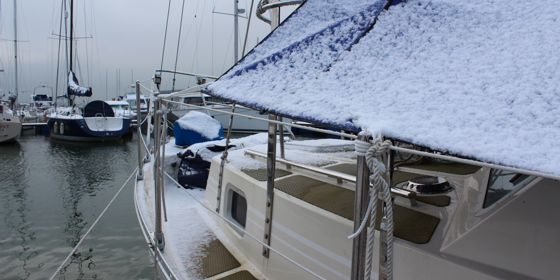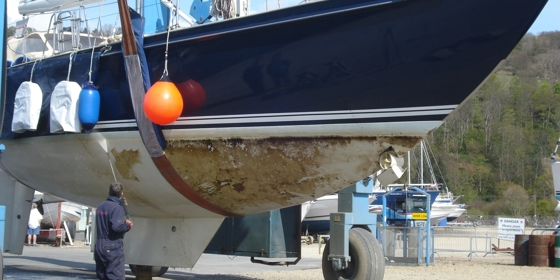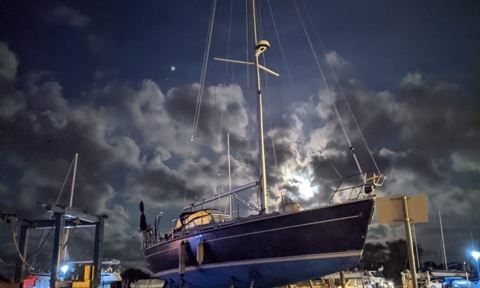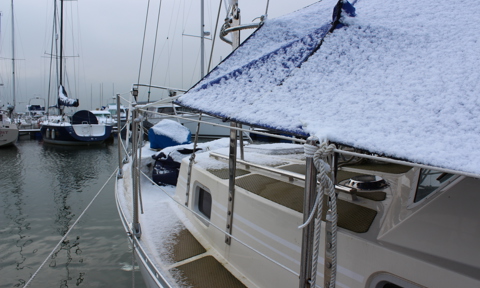Whether you bring your boat ashore for the winter, or you decide to leave her afloat, there are a number of steps to take to ensure your boat stays in tiptop condition.
We've therefore compiled advice from our experienced Haven Teams from around Yacht Havens Group to bring you our TOP FIVE TIPS for winter ashore and for winter afloat.
Winter Ashore - Top 5 Tips
#1 Scrubs
In the first instance, ensure the hull is well-cleaned when lifted ashore (most boatyards offer the pressure wash scrub as standard as part of the lifting and storage service). This winter it will be especially important to ensure this is done well because the warmer summer weather has increased water temperatures, leading to faster algae growth.
#2 Fuel
The dreaded Diesel bug, a microbial bacteria that forms in the air pockets in your tank, can lead to clogged filters, corrosion, damage to the engine and an unwanted bill. The most common method to try to avoid diesel bug is to fill the tank to the brim in an attempt to ensure no air pockets are left in the tank, thus reducing the likelihood of condensation getting inside the tank. Be aware that running your heaters over the winter will burn this fuel meaning your tank may not be full over the coldest months where diesel bug can manifest.
You may also want to explore using an additive such as Marine 16 to reduce the likelihood of diesel bug or FAME-related issues.
#3 Remove sails
Boatyards will ask for all headsails to be removed prior to lifting but it is advisable to remove all sails and sprayhoods if you’re coming ashore for long periods. If you have an in-mast furling mainsail and it cannot be removed, please ensure it is completely furled inside the mast, leaving only the minimum amount of sail exposed. Make sure all locking devices are engaged and regularly checked to prevent accidental unfurling. In addition, we require a strap around the mast above the exposed mainsail as an extra precaution against extreme weather conditions. This will need the approval of the Marina Manager/Yard Manager. We will provide this strap and are happy to assist with the installation to ensure everything is secure. Store them indoors to avoid damp and mould, and don’t forget to take your cushions and bedding with you as well. While you’re removing your sails, don’t forget to ensure there is tension in the backstay.
#4 Water
Drain your water systems as much as possible to de-pressurise the system to reduce the risk of bursting pipes. If it is an especially cold winter, then water will expand when frozen which can lead to cracks and leaks so it is best to reduce the pressure within the tank and pipe system where possible.
#5 Don't touch the shores
Do not tie anything to the props, shores, cradle pads that are keeping your boat fixed in position in the boatyard. Similarly, do not try to move them – if you’re antifouling then ask the hoist crew if they can adjust the shores for you. Alternatively, just leave those final patches until the boat is being relaunched.
#6 (A bonus tip!) Book Early
There’s nothing worse than getting your engineers, painters or tradesman ready, only for your local boatyard to be completely full or without availability in their lifting schedule. Be sure to book your boat hoist/storage AND your marine services as early as possible as the best service providers will be fully booked for the winter well in advance!



Winter Berthing Afloat
#1 One line, one job
Try to avoid the "running W" mooring line (one long line starting at the bow cleat on the finger, to the boat, back to the middle cleat, to the midships cleat on the boat, then to the aft cleat, then finally back to the boat). The "running W" makes it very difficult to adjust lines in a gale. Use separate lines for bow and stern, two long spring lines and, if it makes you rest easier, double-up where you feel necessary. We check boats several times a day during the winter so having your lines like this will allow our Haven Team to make adjustments.
#2 Fendering
If you've got them, use them! We often see boats without enough fenders, but lots in baskets or lockers because the owner thinks they are the wrong size. This may be the case, but it is still more beneficial to use them especially if you’re leaving your boat for a longer period over the winter.
#3 Shackles
Avoid using metal shackles straight on to the pontoon cleats. This will only end up with the shackle or the cleat getting broken. Either way, the end result will be the same - your boat not properly attached to the pontoon finger.
#4 Avoid short lines
It's best to avoid short, tight lines from midships to the centre finger cleat. The line will exert big snatch loads. If you have a midships line, ensure it is long enough to stretch to absorb any load.
#5 Line quality
Before you leave your boat for the winter, check the quality of your moorings lines. Damaged lines will break under heavy loads which will put additional stress on all your good lines. If your line is damaged, the part of the rope in question can be cut out and you could be left with a useable length of rope.
#6 (A bonus tip!) Book Early
There’s nothing worse than getting your engineers, painters or tradesman ready, only for your local boatyard to be completely full or without availability in their lifting schedule. Be sure to book your boat hoist/storage AND your marine services as early as possible as the best service providers will be fully booked for the winter well in advance!




